Hephaestus Audio HMA-1000 monoblock amplifiers
| Who would’ve thought! |
|
|
|
July 2010 |
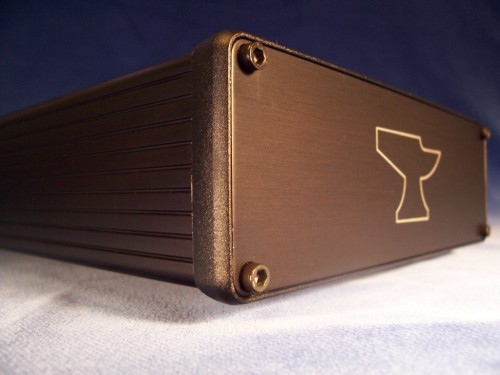
This is an exciting time for both audiophiles and music lovers. We’ve entered a completely different world of high-end audio playback. Mechanical CD players will soon be a thing of the past as sophisticated media servers, laptops, and modified PCs replace them. (I wrote about this at length with my discovery of the Nova Physics Memory Player some five years ago). Consider this: my two top votes for “Best Sound” at the recent Munich 2010 High End Show used digital media servers and “digital” amplifiers from Italy and France. (The inaccurate use of the term “digital” has become ubiquitous for amplifiers that use pulse width modulation, otherwise known as Class D, in their output stage. It is these pulses that are amplified, and then integrated as an analog waveform, typically by a simple low-pass filter.)
It’s been more than ten years since Tact Audio released the Millennium: the world’s first true high-end digital amplifier (which I was among the first to own). John Ulrich was experimenting with Class D amplification decades before that, and eventually started manufacturing amplifiers under the trade name Spectron that were capable of delivering 1000 watts of high fidelity sound into a four-ohm load. Tri-Path was the first digital chip manufacturer to offer the designation Class T, a variation of Class D, chosen in honor of the inventor’s name, Dr. Tripathi. Eventually, Bang and Olufsen introduced their switching amplifier design dubbed “ICE power.” Since then, numerous high-end manufacturers have leveraged the numerous advantages of digital amplification, including high efficiency (above 90%), low heat dissipation, high-speed feedback, shorter signal paths, and reduced parts costs. This, of course, results in a very small and potentially powerful amplifier that doesn’t require massive heat sinks. Newer and improved designs come and go.
But that was then, and this is now…
A longtime Stereo Times supporter dropped me an email encouraging me to audition a new Class-D amplifier called the Hephaestus Audio HMA-1000 (named for the Greek god of fire). Now, what most surprised me, after perusing their website, was that these monoblock designs weighed only 3.5 lbs and yet boasted an output of 1000 watts! My immediate thought, of course, was that such an amplifier was probably all brawn and little brains. In short, I would have bet it lacked the refinement and musicality of top-tier analogue designs. Because my curiosity about digital amplifiers is high, I gave the company a closer look. Reading on, I found that the HMA-1000 is a hand-built Class-D design that employs neither ICE Power nor Tripath technology. Nothing off the shelf, so to speak.
Joey White, the designer of the HMA-1000, built his own Class-D amplifier with a switch-mode power supply. White states that, “What sets a great class-D amplifier apart from a good class-D amplifier is execution. The ideal is not necessarily to be the best in any one particular area – the ideal is to be good in all of the important areas: Sound quality, Noise level, Efficiency, Size/weight, Reliability, Simplicity and Value.” White discusses each of these specific areas and much more on the Hephaestus website.
In many discussions with Joey White, one of his more intriguing responses was to my question, Why build another digital amplifier? White responded at length.”One of the biggest reasons I choose class-D amplifiers may not be what you expect: sound quality. Linear class-AB amplifiers have a ‘kink’ at low levels – right where your brain expects it to be the most linear! Most designs exacerbate this problem by relying heavily on global feedback to ‘sweep the dirt under the rug’. This usually results in an edgy or harsh sound. It just plain isn’t natural and your brain knows it. Class-D amplifiers do not suffer from this problem and the distortion is proportional to the output level – just what your brain expects (note that low global feedback is also required for this to be true). The result is natural sound that doesn’t confuse or mask the original source material. Your brain doesn’t need to do any extra processing to remove the amplifier from the picture – you get to simply relax and enjoy the music!”
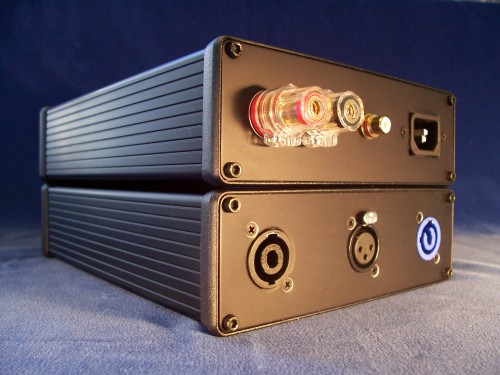
Physically, the HMA-1000 measures 9.0″ x 6.75″ x 2.25″ and is about as bare and unadorned as you’re ever likely to see. No power switch or LED light. White’s rationale was straightforward and concise. “The HMA‐1000 does not include a power LED, as the ubiquitous bright blue LED on many products is a distraction in a dark home theater environment. Regarding the On/OFF function, it is anticipated that the customer will leave the units on continuously (a common audiophile practice) or will use a power conditioner/sequencer. This represents one fewer lossy set of contacts in the power flow.” The rear of the HMA-1000s supports a pair of Neutric 5-way loudspeaker binding posts, a single RCA input, and an IEC power cord connection. In my audio rack, the HMA-1000s looked right at home. Unobtrusive and whisper quiet, the HMA-1000s are compact and understated. These amps were designed to be heard, not seen.
My beloved Revolver Music Series One mini-monitors, which I’ve been enjoying in my downstairs system for many months, have served reliably. The Behold Gentle integrated amplifier is like a Swiss Army Knife in its abilities. Here, working solely as a preamplifier and DAC, I found it allowed the HMA-1000s to perform at their best. The digital source was the remarkable PS Audio PerfectWave transport, while all cabling, including AC power cords, was of the Entreq Konstantin 09 series. Interestingly, the first thing I noticed was the quality of the high frequencies: something most Class-D detesters claim would never improve. 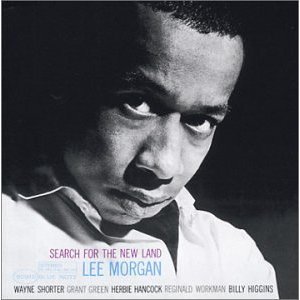 Yet, I could hear improved subtleties in Billy Higgins’ ride cymbal on the track entitled Mr. Kenyatta from Lee Morgan’s explorative and excellent “Search for the New Land.” This was something I did not expect. Yes, I expected the high-power HMA-1000s to increase contrast and dynamics, which they did without a doubt. I also expected the soundstage to increase both laterally and front-to-back because of all that power, control, and grip. What I did not expect, however, was the improved resolution, sense of focus, and added extension to the highs.
Yet, I could hear improved subtleties in Billy Higgins’ ride cymbal on the track entitled Mr. Kenyatta from Lee Morgan’s explorative and excellent “Search for the New Land.” This was something I did not expect. Yes, I expected the high-power HMA-1000s to increase contrast and dynamics, which they did without a doubt. I also expected the soundstage to increase both laterally and front-to-back because of all that power, control, and grip. What I did not expect, however, was the improved resolution, sense of focus, and added extension to the highs.
Search for the New Land was produced by Blue Note Records in 1964 and wasn’t recorded very well. It does, however, feature some of the best jazz musicians who ever lived, which makes it some of the best jazz music ever captured on tape. Herbie Hancock, Wayne Shorter, Reggie Workman, and Grant Green also contribute heavily to this extra special recording. It’s a perfect illustration of a recording that transcends engineering, date, and venue. Whenever I hear this CD – and many others of that era – I appreciate the excellent musicianship, despite the sharp panning and close-microphone techniques employed. Yet, I somehow find myself slack-jawed by the steady state of improvements that come with better components. And the Hephaestus HMA-1000 is one of those components that allows you to appreciate the music (and this particular CD) to a greater extent than I could have imagined.
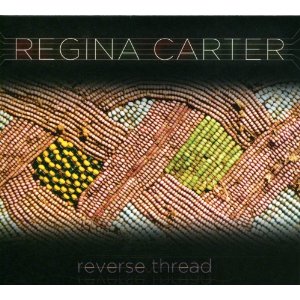
Old recordings sound fuller and more fleshed out, as though they’ve been remastered. On newer,well-recorded music, like the mystical and soul-stirring interpretation of Ayub Ogada’s “Kothbiro” from violinist Regina Carter’s latest CD entitled Reverse Thread, you get the chance to fully appreciate both the technical excellence of the recording and the remarkable artistry on display. “Kothbiro” features Yacouba Sissoko on the kora – a West African 21-string harp customarily played by village storytellers.
What’s so unusually refreshing and wonderfully apparent is hearing Regina interweave her violin with the kora in perfect melody and rhythm. There’s one other element here that’s worthy of mention, too. Drummer and percussionist Alvester Garnett, who’s also an audiophile and long-time contributor to Stereo Times, is featured. Alvester went through painstaking measures with the producers to ensure this recording was made under optimum conditions. And, to my ears, it sounds like Alvester has achieved the results he was seeking. Through the HMA-1000, I could hear almost immediately that Reverse Thread is a reference-level recording. Width, depth, and contrast are revealed with a remarkable degree of harmonic integrity, ease, and dynamics. The 8-Ohm, 89 dB efficient Series One loudspeakers thoroughly enjoyed being pushed to their physical limits by the HMA-1000s. Yet, they never sounded show-offy or lost their composure when played within their limits. I admit to becoming hooked on “Kothbiro” and have been enjoying it night and day. Reverse Thread contains beautifully recorded music from all over the globe. Music that I am certain will be enjoyed for years to come.
Taking the show on the road.
I wanted to see how the HMA 1000s, these little “terrors from tiny town,” would fare in other well-established systems. In particular, I wanted to hear how the HMA-1000s would compete with other Class-D designs, such as the Bel Canto Ref 1000s paired with a pair of Revolver Cygnis loudspeakers in contributor Carlos Sanchez’s system (his comments follow this review). After a brief listen to the REF 1000s, it was clear why so many pairs of these amps are popular among audiophiles: they’re open, dynamically powerful, and yet engaging, while occupying very little real estate. The REF 1000s also have a rated output of 1000 watts. Some subtle sonic differences became immediately apparent. First, with the HMA-1000s, the music took on a more natural appearance, featuring a quieter background and a more refined top end. Both Carlos and I found this troubling, considering how virtually unknown Hephaestus is. Yet, here it was in a side-by-side against the world-renowned REF 1000s and putting up not just a fight but bettering its competitor in high-frequency extension while matching it in the areas of bass dynamics and control. In the end, both Carlos and I agreed that the HMA-1000 possessed a preferred ease and seamlessness. Again, the differences were not significant, but they were big enough for Carlos to desire a pair of HMA-1000s as his new reference. Could the absence of an LED light and a power switch contribute to these sonic differences? There were numerous instances where the Hephaestus HMA-1000s left friends impressed or even dumbfounded.
In sum, these amps were designed to sound as good as the best $10,000 solid-state amplifiers on the market, except you pay only half as much for a pair of HMA-1000s. They’re small, unobtrusive, and reliable, and fit quite comfortably on a shelf in your rack (as I’ve had them running non-stop for over a year). My only hesitation is the lack of a power switch. But maybe it’s better off without one.
Ultimately, I think the Hephaestus HMA-1000s represent a new era of Class-D amplifiers, offering improved linearity, lower noise, and ample power without sounding aggressive. I am proud to have been among the few reviewers who took the leap of faith in hearing this new design from Joey White and am glad I did. Highly recommended.

clement perry
Carlo Sanchez comments on the HMA-1000s!

I must admit that when I was asked to swap out the Bel Canto e. One REF 1000 mono block amp I was enjoying, I did so kicking and screaming! Naturally, I had become very accustomed to the natural ease, fast transient response, and tremendous power that had become synonymous with Class-D designs and, more notably, those from Bel Canto electronics.
The Hephaestus HMA-1000 monoblock amplifier proved to be a lesson well learned, not only in how you can’t judge a book by its cover, but also in how less is more has come into play. Allow me to explain. Upon my first observation of the HMA-1000s, I immediately judged the basic aesthetic as more muted in physical design than what I became accustomed to. When CP requested I “just check these out,” I knew from experience that Mr. P is usually right on in his assessments of what works in a system.
I integrated the HMA-1000 into my simple setup, which consists of the Revolver Cygnis loudspeakers, the Bel Canto CD2 CD player, with its own volume control, and of course, the Bel Canto Ref 1000s (Mk IIs). Because I was using Bel Canto throughout, I knew I had the best component match in terms of synergy. I don’t think any owner of these delicate electronics would argue that point. Another lesson learned. What became immediately apparent was the linear smoothness of Keith Jarrett’s piano on “The Good America” from the Carnegie Hall Concert, compliments of the HMA-1000s. The top-end possessed greater extension, which also sounded a tad silkier on piano. It’s not very difficult to get into a zone listening to Jarrett, but there was something more right about Jarrett’s timing, phrasing, timbre, and tone: offering a new sense of life to this live date that I had not experienced before. While listening, I closed my eyes and felt closer to the concert hall. It was haunting, to say the least.
I must admit that my love for the Bel Canto will always remain. Had I not heard the HMA-1000 monoblocks in my system I would have never even have given them a second thought. They’re not very attractive or possess any sex appeal when compared to Bel Canto. Hephaestus is a brand new company that’s unheard of, boasting an amplifier that’s still unproven outside of a couple of reviews (however, I do think their seven-year warranty shows a remarkable level of confidence). Who would buy this amp? Me, and anyone else who just so happens to enjoy their music collection more than the electronics that drive them. In essence, the HMA-1000s forces you to forget about what’s driving the music. In short order, the HMA-1000s have proven to be ultra-musical while packing a powerful bang for the buck. Don’t be fooled by its small footprint and utilitarian look. I think its minimalist design has a lot to do with its unusually high levels of transparency, coupled with quick and nimble starts and stops (transient speed), bass grip, and control. They more than lived up to the praise CP spoke of before they had even heard of them. In the end, the Hephaestus HMA-1000s won me over by providing a bigger, more natural sound than my beloved Bel Cantos in an even smaller package. Surprised? Yeah, you bet.

![]()
Specifications
• 1.0kWrms into 4Ω / 0.6kWrms into 8Ω
• 2.5kWpeak transient capability into 4Ω
• 85% efficiency from ac input to speaker output
• 20Hz to 20kHz +0.0dB/‐0.5dB frequency response
• 70uVrms noise floor / 119dB SNR (20Hz to 20KHz)
• 26dB gain / 10kΩ input impedance
• 9.0” x 6.75” x 2.25” / 3.5 pounds
Features
• Very high power for effortless sound
• Extremely low noise floor for high resolution
• Compact design benefits multiamp systems
• Neutrik PowerCon® or IEC ac power inlet
• Neutrik Speakon® or gold‐plated binding posts
• Neutrik XLR or gold‐plated RCA input
• SoundPlus™ high performance opamp
Price: $4,900.00
[All Hephaestus Audio products carry a seven‐year warranty.]
Company:
Hephaestus Audio
940 Little Bardfield Road
Webster, NY 14580
585-671-7773
Website: http://hephaestusaudio.com
email. iris@hephaestusaudio.com
![]()
Don’t forget to bookmark us! (CTRL-SHFT-D)
Stereo Times Masthead
Publisher/Founder
Clement Perry
Editor
Dave Thomas
Senior Editors
Frank Alles, Mike Girardi, Russell Lichter, Terry London, Moreno Mitchell, Paul Szabady, Bill Wells, Mike Wright, and Stephen Yan,
Current Contributors
David Abramson, Tim Barrall, Dave Allison, Ron Cook, Lewis Dardick, John Hoffman, Dan Secula, Don Shaulis, Greg Simmons, Eric Teh, Greg Voth, Richard Willie, Ed Van Winkle, Rob Dockery, Richard Doron, and Daveed Turek
Site Management Clement Perry
Ad Designer: Martin Perry



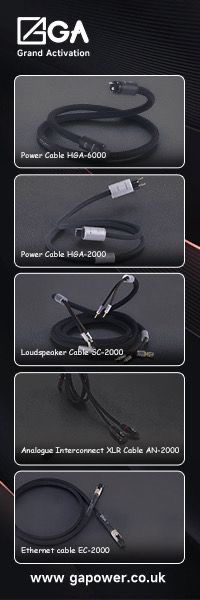

Be the first to comment on: Hephaestus Audio HMA-1000 monoblock amplifiers